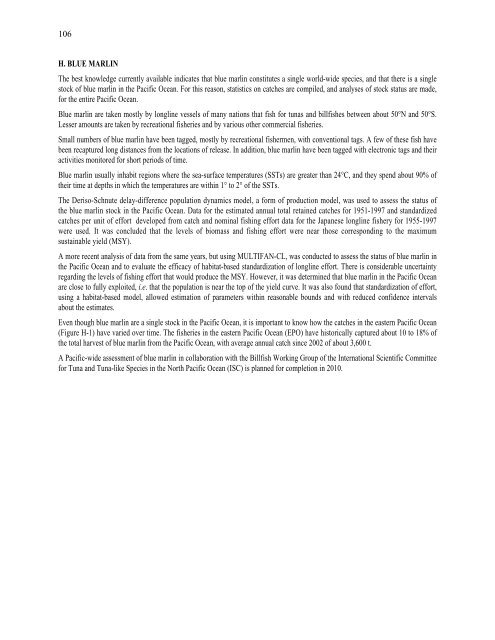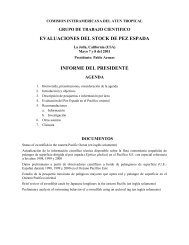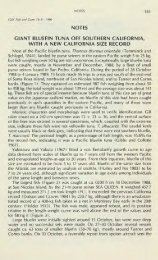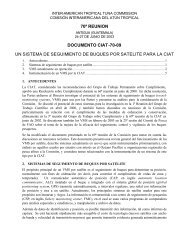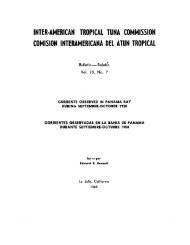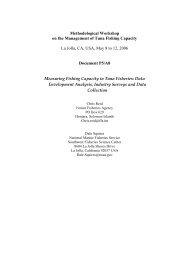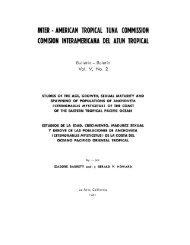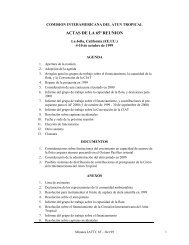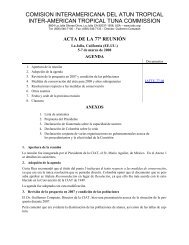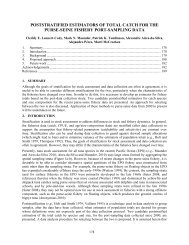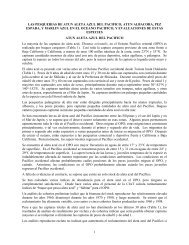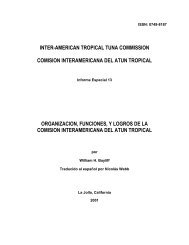INTER-AMERICAN TROPICAL TUNA COMMISSION - Comisión ...
INTER-AMERICAN TROPICAL TUNA COMMISSION - Comisión ...
INTER-AMERICAN TROPICAL TUNA COMMISSION - Comisión ...
- No tags were found...
Create successful ePaper yourself
Turn your PDF publications into a flip-book with our unique Google optimized e-Paper software.
106H. BLUE MARLINThe best knowledge currently available indicates that blue marlin constitutes a single world-wide species, and that there is a singlestock of blue marlin in the Pacific Ocean. For this reason, statistics on catches are compiled, and analyses of stock status are made,for the entire Pacific Ocean.Blue marlin are taken mostly by longline vessels of many nations that fish for tunas and billfishes between about 50°N and 50°S.Lesser amounts are taken by recreational fisheries and by various other commercial fisheries.Small numbers of blue marlin have been tagged, mostly by recreational fishermen, with conventional tags. A few of these fish havebeen recaptured long distances from the locations of release. In addition, blue marlin have been tagged with electronic tags and theiractivities monitored for short periods of time.Blue marlin usually inhabit regions where the sea-surface temperatures (SSTs) are greater than 24°C, and they spend about 90% oftheir time at depths in which the temperatures are within 1° to 2° of the SSTs.The Deriso-Schnute delay-difference population dynamics model, a form of production model, was used to assess the status ofthe blue marlin stock in the Pacific Ocean. Data for the estimated annual total retained catches for 1951-1997 and standardizedcatches per unit of effort developed from catch and nominal fishing effort data for the Japanese longline fishery for 1955-1997were used. It was concluded that the levels of biomass and fishing effort were near those corresponding to the maximumsustainable yield (MSY).A more recent analysis of data from the same years, but using MULTIFAN-CL, was conducted to assess the status of blue marlin inthe Pacific Ocean and to evaluate the efficacy of habitat-based standardization of longline effort. There is considerable uncertaintyregarding the levels of fishing effort that would produce the MSY. However, it was determined that blue marlin in the Pacific Oceanare close to fully exploited, i.e. that the population is near the top of the yield curve. It was also found that standardization of effort,using a habitat-based model, allowed estimation of parameters within reasonable bounds and with reduced confidence intervalsabout the estimates.Even though blue marlin are a single stock in the Pacific Ocean, it is important to know how the catches in the eastern Pacific Ocean(Figure H-1) have varied over time. The fisheries in the eastern Pacific Ocean (EPO) have historically captured about 10 to 18% ofthe total harvest of blue marlin from the Pacific Ocean, with average annual catch since 2002 of about 3,600 t.A Pacific-wide assessment of blue marlin in collaboration with the Billfish Working Group of the International Scientific Committeefor Tuna and Tuna-like Species in the North Pacific Ocean (ISC) is planned for completion in 2010.


